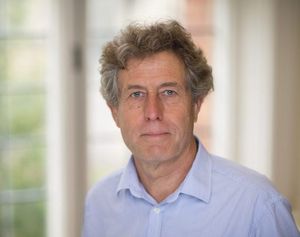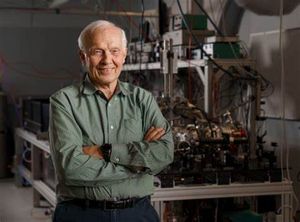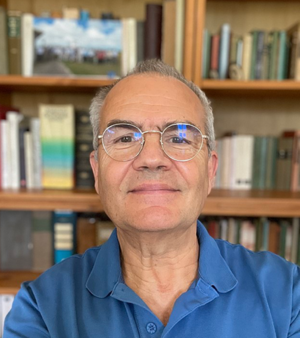Το Σεμινάριο Φυσικής έχει ως στόχο να φέρει τους φοιτητές και το ακαδημαϊκό προσωπικό του Τμήματος από όλους τους Τομείς (Φυσικής Συμπυκνωμένης Ύλης, Αστροφυσικής, Πυρηνικής και Σωματιδιακής Φυσικής, Φυσικής Περιβάλλοντος, και Ηλεκτρονικής Φυσικής) σε επαφή με διεθνώς αναγνωρισμένους ερευνητές που παρουσιάζουν τις νεώτερες επιστημονικές εξελίξεις στη φυσική.
Οι διαλέξεις πραγματοποιούνται στις 5-6 μμ. Η σύνδεση σε αυτά γίνεται μέσω του αντίστοιχου συνδέσμου.

Ημερομηνία: 6/3/2024
Ομιλητής: Prof. Tim Palmer
University of Oxford, UK
Τίτλος: The Geometry of Chaos: The Primacy of Doubt
Περίληψη : In this talk I shall argue that, through meteorologist Ed Lorenz’s discovery of the fractal geometry of chaos, Chaos Theory should be considered the third great theories of 20th Century physics, alongside Quantum Theory and Relativity Theory. Why? Firstly, fractal attractors provide a geometric representation of some of the deepest theorems of 20th Century mathematics. Secondly, this geometry encodes the intermittent instabilities that characterise the occasional breakdown in predictability of many nonlinear systems: from the weather and the motion of planets to the global economy and our health. I discuss the development of practical ensemble prediction tools which enable flow-dependent uncertainties in such nonlinear systems to be forecast and show how this is transforming the way in which humanitarian agencies provide relief to societies at risk of natural disaster. Finally, I will suggest that the geometry of chaos provides a novel way to explain one of the deepest mysteries of quantum physics – its apparent nonlocality. I conclude that such nonlocality does not imply “spooky action at a distance”, but instead signals that our fundamental laws of physics must – like the geometry of chaos – be profoundly holistic.

Ημερομηνία: 17/1/2024
Ομιλητής: Prof. Paul Corkum
Joint Attosecond Science Lab, University of Ottawa and National Research Council of Canada, CA
Τίτλος: A Plasma Perspective on Attosecond Science
Περίληψη : The 2023 Nobel Prize in physics was given for Experimental Attosecond Science, alerting the world to the fastest controlled event that humans can create. I will review the advance, without the experimental filter, emphasizing a broader plasma-like perspective.
The field began in 1964 when Keldysh published a description of atomic ionization in which light-atom interactions is described by tunnelling [1]. Keldysh’s was a revolutionary idea: a static field concept could be applied even where the field is certainly not static. Tunnelling was quickly accepted by the plasma physics community from which I entered strong field physics in 1989 with the two-step model of above-threshold-ionization (ATI) [2,3]. I will describe the 2-step model using first-year undergraduate physics.
I will then show how recollision adds a third step allowing attosecond pulses and how the interplay of the three steps allows an orbital to be imaged. I will also show how the classical-like electron trajectories can be used to measure the time delay in photo ionization, confirming that the three steps are interconnected and allowing attosecond time delay measurements to be performed in a strong light pulse.
1. L. Keldysh, “Ionization in the Field of a Strong Electromagnetic Wave”, JETP 47, (1964).
2. P. B. Corkum et al, "Above Threshold Ionization in the Long Wavelength Limit", PRL 62, 1259 (1989).
3. P. B. Corkum, "A Plasma Perspective on Strong Field Multiphoton Ionization", PRL 71, 1994 (1993).
Παρακολουθήστε την ομιλία εδώ

Ημερομηνία: 22/11/2023
Ομιλητής: Prof. Stefano Vitale
University of Trento, Italy
Τίτλος: From LISA Pathfinder to LISA
Περίληψη : LISA is a space-borne gravitational wave (GW) observatory under development by the European Space Agency (ESA), together with the space agencies of many of its member states and with NASA. It aims at the GW spectrum between a few tens of micro-Hz and a fraction of a Hz, which cannot be accessed by ground-based detectors. Such frequency range gives access, among many other sources, to million solar mass sources at cosmological distances, and to non-transient GW astronomy of our Galaxy. LISA has been preceded by a precursor mission, LISA Pathfinder, operated between 2015 and 2017, that has successfully demonstrated the necessary space-time metrology, while LISA itself is now undergoing the final review, before starting its industrial development for a launch predicted in 2035. The talk will review the concept of the observatory, its vast science promise, including some recent highlights, the science and achievements of LISA Pathfinder, and, finally, the current status of the project and of the large international collaboration behind it.
Παρακολουθήστε την ομιλία: https://youtu.be/_8rf-10IM38